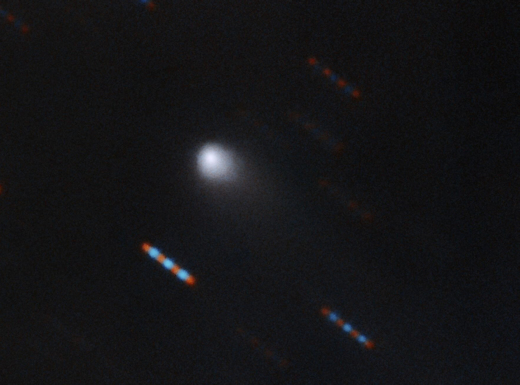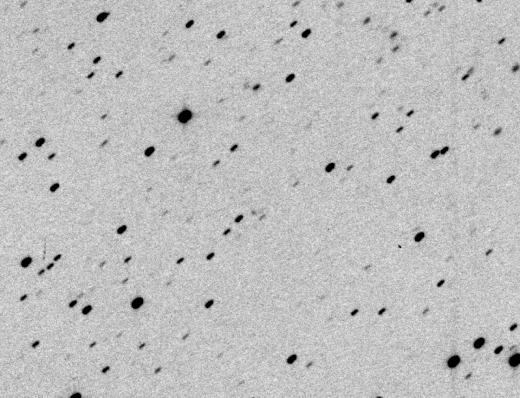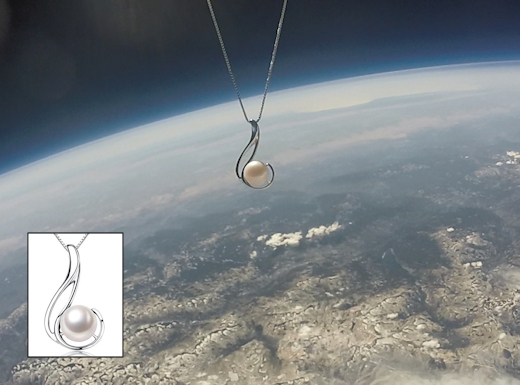Special Offer: SAVE 600nok per person. Book a combo aurora borealis chase and scenic day tour during the months of September, October or November 2019 for the special price of 1800 kr. Check Marianne's webpage for details! | | |
ARCTIC AURORA WATCH: A stream of solar wind flowing from a southern hole in the sun's atmosphere could graze Earth's magnetic field on Sept. 17th. Arctic sky watchers should be alert for auroras mixed with gibbous moonlight when the gaseous material arrives. Aurora alerts: SMS Text.
NEW IMAGES OF COMET BORISOV: It's definitely a comet. New color images from the Gemini telescope atop Hawaii's Mauna Kea volcano show that C/2019 Q4 (Borisov) has a tail. "We really had to scramble for this one since we got the final details at 3:00 am on Sept. 9th and were observing it by 4:45!" says Andrew Stephens of the Gemini Observatory who coordinated the observations.

There are thousands of comets in the Solar System, but this one is special. Comet Borisov is interstellar. The newly-discovered comet is following a hyperbolic orbit with an eccentricity greater than 3.7. This means it is unbound to the sun. Indeed, Comet Borisov is moving 30.7 km/s (68,700 mph) too fast for the sun's gravity to hang onto it. It must have come from the stars.
This is the first time an interstellar visitor to our Solar System has clearly shown a tail due to outgassing. The only other known interstellar visitor was 'Oumuamua in 2017-2018, a cigar-shaped object with no visible comet-like emissions. 'Oumuamua's shape and apparent lack of outgassing led some credible scientists to wonder if it might be an alien probe. The Gemini photo of Comet Borisov shows that it, at least, is a natural object.
On Sept. 12th in Weißenkirchen, Austria, astrophotographer Michael Jäger used a 12-inch telescope to capture his first short video of Comet Borisov:

Note the grey speck moving near the center of the animation. That's the comet.
"It is dim because it is still so far from the sun--about 2.75 AU away," notes Jäger. "Although it has an extraordinary orbit, so far Comet Borisov looks rather ordinary, much like other comets I have seen at such distances."
Because Comet Borisov is still just entering the solar system, astronomers will have plenty of time to study it in the months ahead. Is it truly interstellar? What are comets from other solar systems made of? Answers to these and many other questions are forthcoming.
Meanwhile, if you are a skilled amateur astronomer and wish to observe Comet Borisov, you may find orbital elements for pointing your telescope here and here. Got a picture? Please submit it to our photo gallery!
Realtime Space Weather Photo Gallery
Free: Spaceweather.com Newsletter
PURPLE VOLCANIC SUNSETS: Almost 3 months after the Kirul Islands' Raikoke volcano blasted a plume of sulfurous gas into the stratosphere, sunsets around the northern hemisphere are still turning purple. Dorothea Grolig photographed this example from the Vienna Woods of Lower Austria on Sept. 12th:

Why purple? Fine volcanic aerosols in the stratosphere scatter blue light which, when mixed with ordinary sunset red, produce a purple hue.
The effect is going strong so long after the eruption because Raikoke had help: On Aug. 3rd, New Guinea's Ulawun volcano also punched through to the stratosphere, adding its own emissions to that of Raikoke.
Purple isn't the only thing to look for, says atmospheric optics expert Les Cowley. In addition, he advises, sky watchers should "be alert for a very bright yellow twilight arch, fine cloud structure in the arch seen through binoculars, and long diffuse rays and shadows."
Realtime Volcanic Sunset Photo Gallery
Free: Spaceweather.com Newsletter
THE SPACE PEARL: It's the first pearl in the stratosphere. On Aug. 19, 2019, the students of Earth to Sky Calculus launched a cosmic ray balloon to the edge of space, 104,002 ft high. This sterling silver pearl necklace went along for the ride:

You can have it for $169.95. The students are selling these pearls to support their cosmic ray ballooning program. Each cultured "space pearl" comes with greeting card showing the necklace in flight and telling the story of its journey to the edge of space and back again. These make great birthday and Christmas gifts.
Far Out Gifts: Earth to Sky Store
All sales support hands-on STEM education
Realtime Aurora Photo Gallery
Free: Spaceweather.com Newsletter
Every night, a network of
NASA all-sky cameras scans the skies above the United States for meteoritic fireballs. Automated software maintained by NASA's Meteoroid Environment Office calculates their orbits, velocity, penetration depth in Earth's atmosphere and many other characteristics. Daily results are presented here on Spaceweather.com.
On Sep. 14, 2019, the network reported 24 fireballs.
(24 sporadics)

In this diagram of the inner solar system, all of the fireball orbits intersect at a single point--Earth. The orbits are color-coded by velocity, from slow (red) to fast (blue). [Larger image] [movies]
Potentially Hazardous Asteroids (
PHAs) are space rocks larger than approximately 100m that can come closer to Earth than 0.05 AU. None of the known PHAs is on a collision course with our planet, although astronomers are finding
new ones all the time.
On September 14, 2019 there were 2015 potentially hazardous asteroids.
 |
Recent & Upcoming Earth-asteroid encounters: | Asteroid | Date(UT) | Miss Distance | Velocity (km/s) | Diameter (m) |
| 2019 RX1 | 2019-Sep-09 | 9.7 LD | 13.3 | 30 |
| 2019 RT3 | 2019-Sep-09 | 1.5 LD | 7.6 | 34 |
| 2019 QZ3 | 2019-Sep-09 | 9.7 LD | 7.5 | 40 |
| 2019 RG2 | 2019-Sep-09 | 1.4 LD | 22 | 12 |
| 2019 QY4 | 2019-Sep-10 | 2.5 LD | 7.8 | 10 |
| 2019 RH | 2019-Sep-10 | 7 LD | 16.8 | 23 |
| 2019 RX2 | 2019-Sep-12 | 7.2 LD | 5.3 | 7 |
| 2019 RJ1 | 2019-Sep-12 | 10.8 LD | 10.4 | 15 |
| 2010 RM82 | 2019-Sep-13 | 18.2 LD | 14.6 | 23 |
| 2013 CV83 | 2019-Sep-13 | 16.1 LD | 13.1 | 62 |
| 504800 | 2019-Sep-14 | 13.9 LD | 14.4 | 155 |
| 2019 RT | 2019-Sep-14 | 13.7 LD | 16.6 | 48 |
| 2019 RQ2 | 2019-Sep-14 | 9.4 LD | 17.2 | 29 |
| 467317 | 2019-Sep-14 | 13.9 LD | 6.4 | 389 |
| 2019 JF1 | 2019-Sep-16 | 11.2 LD | 4.3 | 62 |
| 2018 FU1 | 2019-Sep-16 | 18.4 LD | 4.7 | 16 |
| 2019 RC | 2019-Sep-16 | 17.4 LD | 15.1 | 158 |
| 2019 RP2 | 2019-Sep-20 | 8.5 LD | 1.6 | 6 |
| 2017 SL16 | 2019-Sep-21 | 7.9 LD | 6.5 | 25 |
| 2017 SM21 | 2019-Sep-21 | 11.5 LD | 9.6 | 20 |
| 2019 RE2 | 2019-Sep-21 | 19.7 LD | 8.7 | 38 |
| 2019 RB3 | 2019-Sep-21 | 19 LD | 11.8 | 51 |
| 2019 QZ1 | 2019-Sep-22 | 12.5 LD | 8.2 | 77 |
| 523934 | 2019-Sep-24 | 10.9 LD | 22.3 | 257 |
| 2019 QY3 | 2019-Sep-26 | 13.9 LD | 8.4 | 41 |
| 2017 KP27 | 2019-Sep-26 | 4.2 LD | 4.7 | 25 |
| 2006 QV89 | 2019-Sep-27 | 18.1 LD | 4.1 | 31 |
| 2018 FK5 | 2019-Oct-01 | 13.3 LD | 10.5 | 8 |
| 2018 LG4 | 2019-Oct-02 | 13.8 LD | 8.1 | 12 |
| 2017 TJ4 | 2019-Oct-05 | 13.5 LD | 8.9 | 32 |
| 2019 RK | 2019-Oct-08 | 16.7 LD | 3.1 | 32 |
| 162082 | 2019-Oct-25 | 16.2 LD | 11.2 | 589 |
| 2017 TG5 | 2019-Oct-25 | 14.4 LD | 11.9 | 34 |
| 2015 JD1 | 2019-Nov-03 | 12.9 LD | 11.9 | 269 |
| 2010 JG | 2019-Nov-12 | 19.6 LD | 14.9 | 235 |
Notes: LD means "Lunar Distance." 1 LD = 384,401 km, the distance between Earth and the Moon. 1 LD also equals 0.00256 AU. MAG is the visual magnitude of the asteroid on the date of closest approach. | | Cosmic Rays in the Atmosphere |
SOMETHING NEW! We have developed a new predictive model of aviation radiation. It's called E-RAD--short for Empirical RADiation model. We are constantly flying radiation sensors onboard airplanes over the US and and around the world, so far collecting more than 22,000 gps-tagged radiation measurements. Using this unique dataset, we can predict the dosage on any flight over the USA with an error no worse than 15%.
E-RAD lets us do something new: Every day we monitor approximately 1400 flights criss-crossing the 10 busiest routes in the continental USA. Typically, this includes more than 80,000 passengers per day. E-RAD calculates the radiation exposure for every single flight.
The Hot Flights Table is a daily summary of these calculations. It shows the 5 charter flights with the highest dose rates; the 5 commercial flights with the highest dose rates; 5 commercial flights with near-average dose rates; and the 5 commercial flights with the lowest dose rates. Passengers typically experience dose rates that are 20 to 70 times higher than natural radiation at sea level.
To measure radiation on airplanes, we use the same sensors we fly to the stratosphere onboard Earth to Sky Calculus cosmic ray balloons: neutron bubble chambers and X-ray/gamma-ray Geiger tubes sensitive to energies between 10 keV and 20 MeV. These energies span the range of medical X-ray machines and airport security scanners.
Column definitions: (1) The flight number; (2) The maximum dose rate during the flight, expressed in units of natural radiation at sea level; (3) The maximum altitude of the plane in feet above sea level; (4) Departure city; (5) Arrival city; (6) Duration of the flight.
SPACE WEATHER BALLOON DATA: Approximately once a week, Spaceweather.com and the students of Earth to Sky Calculus fly space weather balloons to the stratosphere over California. These balloons are equipped with radiation sensors that detect cosmic rays, a surprisingly "down to Earth" form of space weather. Cosmic rays can seed clouds, trigger lightning, and penetrate commercial airplanes. Furthermore, there are studies ( #1, #2, #3, #4) linking cosmic rays with cardiac arrhythmias and sudden cardiac death in the general population. Our latest measurements show that cosmic rays are intensifying, with an increase of more than 18% since 2015:

The data points in the graph above correspond to the peak of the Reneger-Pfotzer maximum, which lies about 67,000 feet above central California. When cosmic rays crash into Earth's atmosphere, they produce a spray of secondary particles that is most intense at the entrance to the stratosphere. Physicists Eric Reneger and Georg Pfotzer discovered the maximum using balloons in the 1930s and it is what we are measuring today.
En route to the stratosphere, our sensors also pass through aviation altitudes:

In this plot, dose rates are expessed as multiples of sea level. For instance, we see that boarding a plane that flies at 25,000 feet exposes passengers to dose rates ~10x higher than sea level. At 40,000 feet, the multiplier is closer to 50x.
The radiation sensors onboard our helium balloons detect X-rays and gamma-rays in the energy range 10 keV to 20 MeV. These energies span the range of medical X-ray machines and airport security scanners.
Why are cosmic rays intensifying? The main reason is the sun. Solar storm clouds such as coronal mass ejections (CMEs) sweep aside cosmic rays when they pass by Earth. During Solar Maximum, CMEs are abundant and cosmic rays are held at bay. Now, however, the solar cycle is swinging toward Solar Minimum, allowing cosmic rays to return. Another reason could be the weakening of Earth's magnetic field, which helps protect us from deep-space radiation.
| | The official U.S. government space weather bureau |
| | The first place to look for information about sundogs, pillars, rainbows and related phenomena. |
| | Researchers call it a "Hubble for the sun." SDO is the most advanced solar observatory ever. |
| | 3D views of the sun from NASA's Solar and Terrestrial Relations Observatory |
| | Realtime and archival images of the Sun from SOHO. |
| | from the NOAA Space Environment Center |
| | fun to read, but should be taken with a grain of salt! Forecasts looking ahead more than a few days are often wrong. |
| | from the NOAA Space Environment Center |
| | the underlying science of space weather |
 | To find reviews of new online casino sites in the UK try The Casino DB where there are hundreds of online casino reviews complete with bonuses and ratings. Looking for a new online casino? Try Casimpo the new site dedicated to making online casino simple and easy for all. |
| | These links help Spaceweather.com stay online. Thank you to our supporters! |
| | | | | | |

